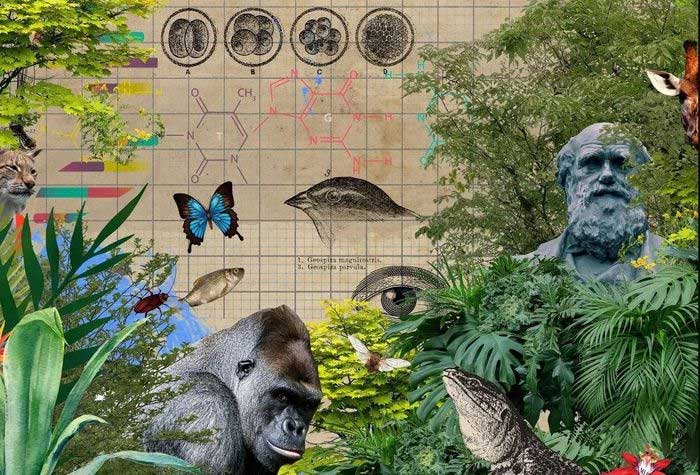On June 7, scientists announced the results of research on primitive steroids to solve the long-standing mystery of how the first complex life forms evolved.
Primordial steroids discovered in 1.6 billion-year-old rocks could help scientists solve the age-old mystery of the evolution of single-celled life . These compounds are produced by eukaryotes, i.e. cells with nuclei and internal organelles enclosed by membranes. Modern eukaryotes include plants, fungi, and animals. In contrast, prokaryotes – bacteria and archaea – lack these characteristics. Based on molecular data, researchers know that single-celled eukaryotes first evolved at least 2 billion years ago, but there is little fossil record of their earliest days.
Particularly puzzling is that the steroids that eukaryotes produce as part of their membranes do not appear in the fossil record until about 800 million years ago. The last common ancestor of modern eukaryotes (including us today) appeared on Earth about 1.2 billion years ago, and scientists believe that is the origin that created these steroids. It is that misconception that leads to confusion as to why they do not appear in ancient rocks.
Now, researchers have discovered that they were looking for the wrong thing. Instead of looking for shelled steroid compounds as they are now, they discovered precursors from the first steps in bacterial metabolism. The team published their results on June 7 in the journal Nature.

Organisms evolved from single-celled organisms to the abundant life forms they have today.
Study first author Jochen Brocks, a professor at the School of Earth Sciences at the Australian National University, said : “It (primordial steroids) was like something that happens every day, but they are we don’t “see” it. But once we know what it looks like, we suddenly see it everywhere.”
Realm of eukaryotes
After the researchers figured out which molecules to look for, they found them throughout sedimentary rocks from 1 billion to 1.6 billion years ago. Brocks says that changes the picture of what researchers believe about the early abundance of eukaryotes (the three kingdoms of animals, plants and fungi).
“We previously thought that eukaryotes were very low in numbers or restricted to marginal environments where molecular fossils could not be found,” he said . It now appears that more primitive forms can be quite abundant even in marine habitats.”
The compounds were first found in rocks that formed on the bottom of ancient oceans, discovered above ground in northern Australia. However, as researchers expanded their search for billions of years old rocks across the globe, they found traces of ancient steroids from around the world, including in West Africa, Scandinavia and China. Country.
The oldest samples are 1.64 billion years old; Scientists have yet to find older rocks that are well preserved for analysis. In addition, Brocks says in their data records there is still a time gap between 800 million and 1 billion years ago, because very little sea rock from that time period still exists. However, that period is right around the time when modern eukaryotes are most likely to begin to emerge. So it is important to fill those gaps in order to solve all the questions.
The turning point in the evolution of organisms
Laura Katz, a biologist at Smith College who studies eukaryotic evolution but was not involved in the study, said the new finding was a “significant step forward” in adding to the data . is missing about early eukaryotes.
“This scientific report is helping us understand the early eukaryotes and helping us to imagine what they might have looked like,” Katz said .
Andrew Roger, a molecular biologist at Dalhousie University in Canada, who was not involved in the study, also said these organisms evolved in a very different environment from today’s. Roger said that the Earth’s atmosphere did not contain significant levels of oxygen until 2.4 billion years ago and did not reach the present oxygen levels until 650 million years ago.
“Atmospheric oxygen levels probably played an important role in the evolutionary timing of eukaryotes, since most eukaryotes use oxygen for their metabolism,” he said . There is even the possibility that newly developed steroids have allowed the original eukaryotes to move into new oxygen-rich environments.”
It was a breakthrough step from a single-celled organism to a multi-celled organism, to an animal and then to us humans. Remember, it took just over 3 million years to evolve from apes to humans, but to evolve from single-celled organisms to multi-celled organisms took us billions of years.
Steroids are a class of organic compounds containing a characteristic arrangement of four cycloalkane rings joined together. Examples of steroids include the cholesterol-eating fats, the sex hormones estradiol and testosterone, and the anti-inflammatory drug dexamethasone. The core of the steroid consists of 20 carbon atoms bonded together taking the form of four fused rings: three cyclohexane rings (referred to as A, B, and C rings in the right figure) and one cyclopentane ring (D ring). . The steroids differ for each functional group attached to the four-ring core and the oxidation of the rings.
Steroids are fat-soluble organic compounds of natural or synthetic origin that are composed of 17 carbon atoms arranged in four rings and include sterols and bile acids, adrenal, and hormones. sex. Some steroids are of natural origin, such as digitalis compounds, and precursors of certain vitamins.
